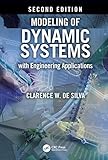Modeling of Dynamic Systems with Engineering Applications / Clarence W. de Silva,
Material type: TextPublication details: Boca Raton, Florida CRC Press 2023Edition: 2nd EdDescription: xix, 400p. : ill. ; 26cmISBN:
TextPublication details: Boca Raton, Florida CRC Press 2023Edition: 2nd EdDescription: xix, 400p. : ill. ; 26cmISBN: - 9780367644215
- 620.001185 DE S
| Item type | Current library | Collection | Call number | Status | Notes | Date due | Barcode | |
|---|---|---|---|---|---|---|---|---|
| Reference Book | VIT-AP General Stacks | Reference | 620.001185 DE S (Browse shelf(Opens below)) | Not For Loan (Restricted Access) | MECH | 020324 | ||
| Text Book | VIT-AP General Stacks | 620.001185 DE S (Browse shelf(Opens below)) | Available | MECH | 020325 | |||
| Text Book | VIT-AP General Stacks | 620.001185 DE S (Browse shelf(Opens below)) | In transit from VIT-AP to School of Mechanical Engg Section since 2025-04-15 | MECH | 020326 |
It includes Appendix and Index pages.
This book provides cutting edge insight into systems dynamics, as applied to engineering systems including control systems. The coverage is intended for both students and practicing engineers. Updated throughout in the second edition, it serves as a firm foundation to develop expertise in design, simulation, prototyping, control, instrumentation, experimentation, and performance analysis.
Providing a clear discussion of system dynamics, the book enables students and professionals to both understand and subsequently model mechanical, thermal, fluid, electrical, and multi-physics systems in a systematic, unified and integrated manner, which leads to a "unique" model. Concepts of through-and across-variables are introduced and applied, alongside tools of modeling and model-representation such as linear graphs and block diagrams. The book uses and illustrates popular software tools such as SIMULINK, throughout, and additionally makes use of innovative worked examples and case studies, alongside problems and exercises based on practical situations.
Description:
The book is a crucial companion to undergraduate and postgraduate mechanical engineering and other engineering students, alongside professionals in the field. Complete solutions to end-of-chapter problems are provided in a Solutions Manual that is available to instructors.
Table of Contents:
Chapter 1 Introduction to Modeling
Chapter 2 Basic Model Elements
Chapter 3 Analytical Modeling
Chapter 4 Model Linearization
Chapter 5 Linear Graphs
Chapter 6 Frequency-Domain Models
Chapter 7 Transfer-Function Linear Graphs
Appendix A: Graph-Tree Concepts for Linear Graphs
Appendix B: MATLAB Toolbox for Linear Graphs
There are no comments on this title.

